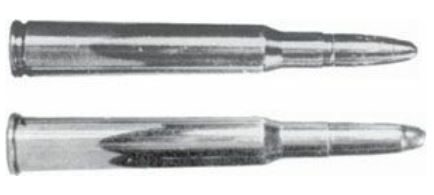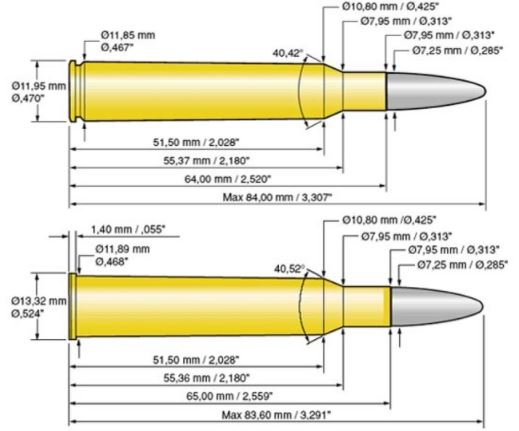7x64 Brenneke

The 7×64mm, also known (unofficially) as the 7×64mm Brenneke, is a rimless bottlenecked centerfire cartridge developed by Wilhelm Brenneke for hunting medium to large game in 1917. Typical of European cartridges, the 7 denotes the 7 mm (.284 caliber) bullet, and the 64 denotes the 64 mm (2.5 in) case length. The 7×64 Brenneke is a popular hunting cartridge, especially in Central Europe due to its 11.95 mm (0.470 in) case head diameter and 84 mm (3.3 in) overall length. This allows the cartridge to easily be chambered in the Mauser 98 bolt-action rifle that was once the standard German infantry rifle.
The 7x64mm cartridge also has a rimmed counterpart, the 7x65R, which is nearly identical, but features a rim in order to be more easily utilized in single-shot and combination firearms. Both cartridges are still in commercial production today.
Ballistic Performance
| Bullet Weight / Type | Velocity | Muzzle Energy |
|---|---|---|
| 140 gr (Soft Point) | 3,000 fps | 2,810 ft lbs |
| 154 gr (Soft Point) | 2,900 fps | 2,877 ft lbs |
| 174 gr (Soft Point) | 2700 fps | 2,833 ft lbs |
| 173 gr (RWS' H-MANTEL, Capped HP) | 2,840 fps | 3,104 ft lbs |
History
At the beginning of the 20th century, famous German small arms inventor and designer Wilhelm Brenneke (1865–1951) experimented with the engineering concept of lengthening and other dimensional changes regarding standard cartridges like the M/88 cartridge case, which was used by the German military in their Mauser Gewehr 98 rifles, to obtain additional muzzle velocity.
In 1912, Brenneke designed the commercially rather unsuccessful 8×64mm S cartridge (again in production since 2001). It was intended as a ballistic upgrade for the Mauser Gewehr 98 rifles that were standard issue in the German armed forces. The German military chose, however, to stay with their 8×57mm IS rifle cartridge avoiding rechambering their service rifles for a cartridge that, due to its more favourable bore area to case volume ratio, would ballistically outperform the .30-06 Springfield cartridge of the United States Army. Brenneke’s engineering concept was to create new, very powerful cartridges (for the era) by enlarging exterior cartridge case dimensions such as overall length and larger case head diameter compared to the German 8×57mm IS military cartridge case, along with an increase in maximum pressure. The concept was sound, and he persisted in the development of such new cartridges.
In 1917 Brenneke necked down his 8×64mm S design of 1912 to 7mm (.284 caliber) and introduced it as the 7×64mm, and achieved major commercial success. The 7×64 cartridge offered 10-12% more muzzle velocity than the 7×57mm Mauser. This results in a flatter trajectory and better performance at longer range. In the years between World War I and World War II, the 7×64mm was regarded by German hunters as a "miracle cartridge". Dozens of different factory loads were available on the German market. The round was so highly regarded that the Nazi German Wehrmacht even considered replacing the 8×57mm IS in favor of the 7×64mm for their snipers during the 1930's. However, the Wehrmacht decided — as the German Army had in 1912 — to continue using 8×57mm IS cartridges for their Mauser Karabiner 98k's to keep logistics simple.
Besides the 7×64 Brenneke rifle cartridge, he also designed a rimmed version for break action rifles such as single-shot rifles, double rifles and combination guns in 1917. The rimmed 7×65mmR variant of the cartridge was also a big success.
Many countries have banned the use of military service cartridges for civilian use. In such countries, the 7×64 Brenneke has been a popular cartridge for hunting and marksmanship.
Cartridge Dimensions & Specifications
The diagram below shows dimensions for the 7x64 Brenneke, as well as its rimmed variant, the 7x65R.

- Parent case: 8×64mm S
- Case type: Rimless, bottleneck
- Bullet diameter: 7.25 mm (0.285 in)
- Neck diameter: 7.95 mm (0.313 in)
- Shoulder diameter: 10.80 mm (0.425 in)
- Base diameter: 11.85 mm (0.467 in)
- Rim diameter: 11.95 mm (0.470 in)
- Rim thickness: 1.30 mm (0.051 in)
- Case length: 64.00 mm (2.520 in)
- Overall length: 84.00 mm (3.307 in)
- Case capacity: 4.48 cm3 (69.1 gr H2O)
- Rifling twist: 220 mm (1-8.66")
- Primer type: Large rifle
- Maximum pressure (C.I.P.): 415.00 MPa (60,191 psi)
- Maximum pressure (SAAMI): 379.21 MPa (55,000 psi)
- Maximum CUP: 50,500 CUP
Americans would define the shoulder angle at alpha/2 ≈ 20.42 degrees. The common rifling twist rate for this cartridge is 220 mm (1 in 8.66 in), 4 grooves, Ø lands = 6.98 mm, Ø grooves = 7.24 mm, land width = 3.70 mm and the primer type is large rifle or large rifle magnum depending on the load.
According to the official C.I.P. (Commission Internationale Permanente pour l'Epreuve des Armes à Feu Portatives) rulings the 7×64 Brenneke can handle up to 415.00 MPa (60,191 psi) Pmax piezo pressure. In C.I.P. regulated countries every rifle cartridge combination has to be proofed at 125% of this maximum C.I.P. pressure to certify for sale to consumers. This means that 7×64mm chambered arms in C.I.P. regulated countries were, as of 2014, proof tested at 519.00 MPa (75,275 psi) PE piezo pressure.
The SAAMI maximum average pressure (MAP) for this cartridge is 55,000 psi (379.21 MPa) piezo pressure.
The American .280 Remington cartridge is likely the closest ballistic twin of the 7×64mm. When compared to the 7×64mm, the .280 Remington has a slightly lower maximum allowed chamber pressure and as an American 7 mm cartridge, it has a slightly smaller groove diameter. European 7 mm cartridges have 7.24 mm (0.285 in) grooves Ø diameter. American 7mm cartridges have 7.21 mm (0.284 in) grooves Ø.
Modern Use
The 7×64mm Brenneke is a popular rifle cartridges in Central Europe, and is offered as a chambering option in every major European hunting rifle manufacturer's product palette. It is a versatile cartridge for all kinds of European game. Likewise, the availability of numerous factory loads all attribute to the 7×64mm continued popularity. Loaded with shorter, lighter bullets, it can be used on small European game like fox and geese, or medium game such as roe deer and chamois. When loaded with longer, heavier projectiles, it can be used on big European game like boar, red deer, moose and even brown bear. The 7×64mm cartridge offers good penetration due to a fast twist rate that enables it to fire long, heavy bullets with a high sectional density. The 7×64mm's rimmed sister cartridge, the 7×65mmR, is also very popular in Central Europe for the same reasons. The banning of military service cartridges like the .308 Winchester, 7×57mm Mauser, 8×57mm I, 8×57mm IS and the .30-06 Springfield in nations such as France or Belgium, also promoted acceptance of both the 7×64mm and the 7×65mmR.